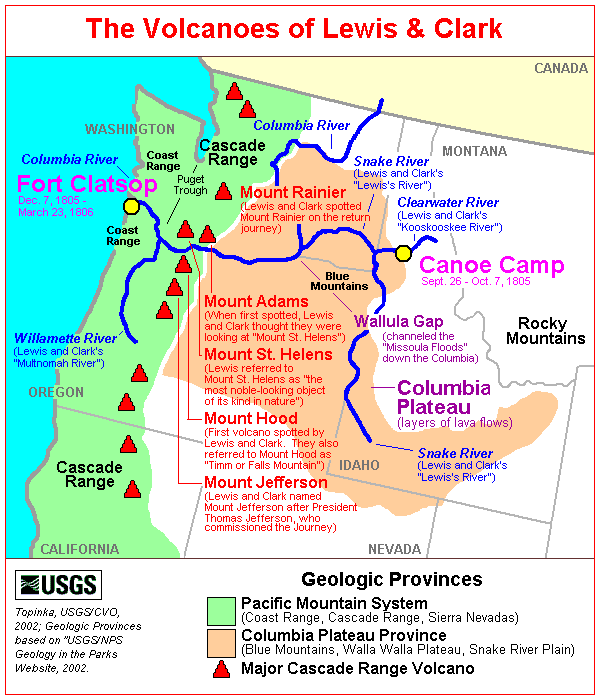
(Click map for brief summary about the area)

The Volcanoes of Lewis and ClarkApril 13, 1806 |
|
Home
-- The Volcanoes of Lewis and Clark Map of the Journey -- Volcanoes, Basalt Plateaus, Major Rivers, etc. CALENDAR of the Journey -- October 1805 to June 1806 Along the Journey -- Pacific Northwest Maps - Columbia River, Volcanoes, Flood Basalts, Missoula Floods, Geology, etc. The Corps of Discovery -- The Journey of Lewis and Clark About the Reference Materials -- The Journals, Biddle/Allen, DeVoto, Gass, Moulton, Topo Maps, and others USGS Lewis and Clark Links -- Links to USGS Websites highlighting the Lewis and Clark Journey Resources Publications Referenced and Websites Visited |
PREVIOUS
April 10-12 Columbia River Gorge, Cascade Locks Vicinity |
April 13
Columbia River Gorge, Cascade Locks to Dog Mountain Cascade Locks, Wind River, Wind Mountain, Dog Mountain |
CONTINUE
April 14 Columbia River Gorge, Dog Mountain to Major Creek |
| On October 7, 1805, Lewis and Clark and the "Corps of Discovery" began their journey down the Clearwater River and into the volcanics of the Pacific Northwest. The Corps travelled from the Clearwater to the Snake and down the "Great Columbia", finally reaching the Pacific Ocean on November 15, 1805. Along the journey they encountered the lava flows of the Columbia Plateau, river channels carved by the great "Missoula Floods", and the awesome beauty of five Cascade Range volcanoes. |

| The Volcanoes of Lewis and Clark |
| Heading Home - April 1806 |
|
Columbia River Gorge
Cascade Locks to Wind River |
| Lewis and Clark's camp of April 12, 1806, was on the Washington side of the Columbia River, above the Cascade Locks, just north of today's Bridge of the Gods. In the end of October in 1805 the Lewis & Clark expedition reached the Schutes of the Columbia, in the area today known as Cascade Locks. The expedition was forced to portage around these falls on November 1st, and again on their return trip in the spring of the following year. The falls were later bypassed by the development of a set of locks in 1896, and subsequently drowned with the competion of the Bonneville Dam in 1938. |
| The loss of our periogue yesterday obliges us to distribute our leading between the two canoes, and the two remaining periogues. This being done, we proceeded along the north side of the river [Washington State], but soon finding that the increased loading rendered our vessels difficult to manage, if not dangerous in case of high wind, the two periogues only continued on their route, while captain Lewis with the canoes crossed over to the Yehhuh village, with a view of purchasing one or two more canoes. ...... He [Captain Lewis] proceeded along the south side of the river [Oregon], and joined us in the evening. We had gone along the north shore as high as Cruzatte's river [Wind River], to which place we had sent some hunters the day before yesterday, and where we were detained by the high winds. |
| Lewis and Clark are passing through the heart of the Columbia River Gorge. Some of the volcanic features they are passing in this area are Shellrock Mountain (Oregon), and Wind Mountain (Washington). |
| The hunters however did not join us, and we therefore, as soon as the wind had abated, proceeded on for six miles, where we halted for captain Lewis, and in the meantime went out to hunt. [vicinity of Dog Mountain] ...... |
| "... we passed Crusatte's river, when the wind rose so high we could not go on, so we halted and waited for Capt. Lewis. Two hunters went out about 3 hours, but killed nothing. By this time the wind fell and we went on 3 miles to a better harbour, where we halted on the north side of the river. Capt. Clarke and 3 men went out to hunt; and Capt. Lewis having come up and rossed over to us, we fixed our camp for the night ..." [Gass, April 13, 1806] |
| "... we proceeded on little above cruzattes River the wind rose So high that obledged us to halt at this bottom where we expected to find our Hunters ... the day proved fair the wind cold and Snow laying low on the Mountains near the River. ... we then proceed. on about 5 miles and halted again at a bottom on the N. Side 3 men went out a hunting. Sergt. Pryor & 2 men Sent back to cruzattes River to look again for the hunters one of the hunters killed two Deer. Capt. Lewis & party overtook us had purchased two Small canoes the price of which was 2 Small peaces of blue cloath and two Elk hides, & bought three dogs also. we dryed the 2 Small canoes by fire and pitched them &c.; ..." [Ordway, April 13, 1806] |
|
|
|
The Camp - April 13, 1806:
Lewis and Clark camped on the Washington side of the Columbia, near Dog Mountain, between Collins Creek and Dog Creek. |
Return to:
[Volcanoes and History Menu] ...
[Living With Volcanoes Menu] ...
